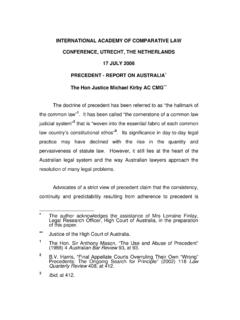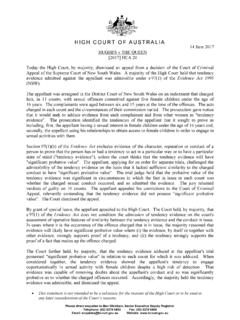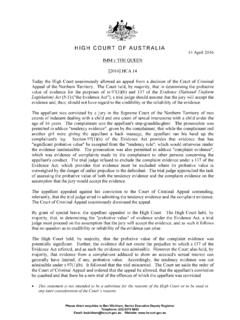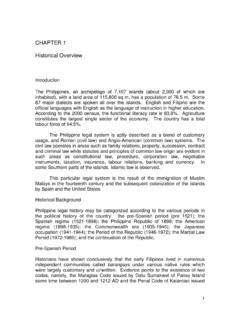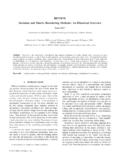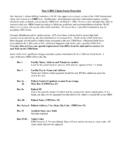Transcription of The Story behind the Land Borders of the Australian States ...
1 1 The Story behind the land Borders of the Australian States - A Legal and historical overview Delivered by Dr Gerard Carney Public Lecture Series, High Court of Australia 10 April 2013 Introduction I think it is safe to say that every Australian is able to draw roughly the land Borders of the six Australian States and of the Northern Territory. Less well known is the history behind these Borders . This lecture attempts to trace that history in terms of when, how and why these Borders were drawn where they are. Time does not permit consideration of the coastline boundaries, which were determined by a majority of the High Court in the Seas and Submerged Lands Act Case in 1975 to lie at the low-water mark. 1 So, my apology to Tasmania which barely rates a mention in this lecture! Nor do I cover the boundary of the Australian Capital Territory within New South Wales. Geographical barriers are usually the most effective land Borders , such as mountain ranges, rivers, lakes, gorges, or deserts.
2 All of these geographical features have played some role in the drawing of Australia s boundaries. But their role has been a secondary one on the mainland due to the extraordinary distances involved, and the fact that the internal geography of the continent was largely unknown at the time the UK authorities felt the need to define Australia s land Borders . Instead, primary reliance was placed on the meridian lines of longitude (measured from the prime meridian at Greenwich2) and parallels of latitude (measured from the equator) referred to by one commentator as those celestially-described boundaries . Why particular lines of longitude and latitude were selected is not entirely clear. 1 New South Wales v Commonwealth (1975) 135 CLR 337. 2 The Greenwich prime meridian was internationally adopted in 1884 at the International Meridian Conference at Washington DC, although it was adopted by Britain well before that.
3 2 A significant determinate of a nation s boundary is, of course, international law. In this respect, many may be surprised by the fact that the first land boundary created by the British on this continent in 1786 can be traced to a treaty between Portugal and Spain in 1494. An important role often overlooked is that of the early surveyors of this continent whose arduous task was to physically mark out the actual boundaries between the colonies. They had to undertake complex calculations to arrive at the most accurate measurements then possible, knowing that their instruments denied them the mathematical accuracy they so earnestly sought. They also had to cope with a harsh environment which threatened their very survival. Nor was their ordeal over, when years later, some of their work is the subject of constitutional challenge in this Court! So a study of Australia s land boundaries involves the intersection of politics, constitutional and international law, geography, science, and at least up to the 19th century, stories of human endurance.
4 The most practical way to tell this Story is to do so chronologically. Pre-European settlement Before European settlement of Australia, what was the position as far as territorial boundaries were concerned? Ronald and Catherine Berndt s classic work, The World of the First Australians3, describes an ancient continent inhabited by around 500 tribes, each having a territory from which they believed they had been created. In Mabo v Queensland No2, Deane and Gaudron JJ observed that in 1788: The boundaries of their traditional lands were likely to be long-standing and defined. 4 1770 When Captain Cook took possession , in the name of His Majesty George III, of the whole eastern coast of Australia in August 1770 at Possession Island, it seems that he did not bother to accord this territory a new name. Hawkesworth, the editor of his Journal, is credited with deriving the name: New South Wales.
5 Nor did Captain Cook define any western boundary for this new British possession. He only purported to take possession of the coastline which he saw and which he felt sure no European had previously seen, namely, from the northern tip of Cape York, south to Point Hicks. For this reason, he did not take possession further south, especially since Abel Tasman had, during his first voyage on 3 December 1642, purported to take possession on behalf of the Prince of 3 Second edition 1977, Ure Smith Sydney, espec at 32-33. 4 (1992) 175 CLR 1 at 99. 3 Holland of an unidentified part of Van Diemen s Accordingly, the precise area of the new British possession remained obscure. 1786 This was remedied in 1786 when the boundaries of the first British colony in the Pacific Ocean were defined by the two commissions issued to Captain Arthur Phillip appointing him Governor of the penal settlement of New South Both commissions defined the boundaries of New South Wales as extending from the Northern Cape of Cape York to the southern coast of Van Diemen s land and west to 135 east longitude, including the adjacent Pacific Islands.
6 Selection of 135 east longitude (which I will refer to as the 135 meridian) meant that New South Wales extended from the eastern coastline across almost half of the continent. The western half of the continent remained unclaimed by any foreign power, and continued to be referred to as New Holland. Map 1 5 Bill Gammage, Early Boundaries of New South Wales historical Studies, vol 19 no 77, 1981, at p 524. 6 historical Records of New South Wales Series I vol I pp1-8. 4 Why was the 135 meridian chosen? The answer seems to have its origins in an agreement reached between Spain and Portugal by the Treaty of Tordesillas on 7 June 1494. Map 2 By this treaty, they divided between them the world outside Europe, then thought to be flat, by reference to a line of longitude 370 leagues west of the Cape Verde Islands. This was the supposed mid-point of the Atlantic Ocean between Europe and the recently discovered New World.
7 This agreement slightly adjusted in Portugal s favour the settlement brokered the year before by Pope Alexander VI and proclaimed in a Papal Under the 1494 Treaty, Portugal had dominion over all lands east of the Tordesillas Line, while Spain had dominion over all lands west of that The circumnavigation of the globe by Ferdinand Magellan from 1519 to 1522 effectively converted the dominions of Portugal and Spain into hemispheres. This led, however, to a dispute over the specific meridian defining their respective hemispheres in the Pacific (referred to as the anti-meridian) because they calculated the Tordesillas Line from different points in the Cape Verde Islands. Portugal calculated the Tordesillas Line further west at effectively 51 west longitude, the anti-meridian of which is 129 east longitude. Whereas Spain calculated the Tordesillas Line east of Portugal s line at effectively at 45 west longitude, the anti-meridian of which is 135 east longitude (ie the 135 meridian).
8 9 7 The Papal Line of 1493 issued by Pope Alexander VI was 100 leagues west of the Cape Verde Islands: see Leslie R Marchant, The Political Division of Australia 1479-1829: The historical Development of the Western Australian Border Cartography, vol 29, no 1 June 2000, at p 33. 8 Cf the Treaty of Alcacovas of 1479 which gave the northern hemisphere above 27 degrees north latitude to Spain and the southern hemisphere to Portugal. This latitude is at the southern edge of the Canary Islands. 9 Bill Gammage, Early Boundaries of New South Wales historical Studies, vol 19 no 77, 1981, at p 529. 5 It seems that at least by the end of the 16th century the Spanish view prevailed with the anti-meridian of the Tordesillas Line being commonly accepted at the 135 This enabled Spain to develop its monopoly over the Americas and the Pacific Ocean during the ensuing three centuries.
9 Consequently, the Dutchman, Abel Tasman, in 1644 named only the western half of the new continent as New Holland, leaving the eastern half as Terra Australis within the dominion of This avoided any additional conflict with Spain, against whom Holland was fighting for independence, while at the same time assuming control of the East Indies from the This appears to explain why in 1786 the British selected the 135 meridian as the western boundary of New South Wales, leaving untouched the western half of the continent known as New Holland. They did not wish to offend the Dutch before signing them up with Prussia and Holland in 1788 to form the Triple Alliance13 as a buffer to the French. While this may explain why the British did not lay claim to the whole continent, it does not explain why the Portuguese line at 129 East longitude (which I will refer to hereafter as the 129 meridian) was not selected.
10 A possible explanation was the need to keep clear of Timor to avoid any possible conflict with Portuguese and Dutch control over that Although priority was given in 1788 to ensuring no offence to the Dutch, the British remained mindful of the Spanish claim to Terra Australis and, in particular, to Spain s claim of exclusive sovereignty and navigation rights in the Pacific. However, this claim dissolved with the loss of French naval support following the French Revolution in 1789. Spain was then forced to concede by a Convention of 28 October 1790, Britain s rights to navigate, fish, trade in and settle any unoccupied areas of the Pacific Nonetheless, potential French and Dutch claims led to growing concern at the commencement of the 19th century over the future of the western half of the continent. The Dutch regained ambitions in the East Indies following the defeat of Napoleon in 1815 and after the return of Java from the 10 See Leslie R Marchant, The Political Division of Australia 1479-1829: The historical Development of the Western Australian Border Cartography, vol 29, no 2 December 2000, Part II at p 5; Bill Gammage, Early Boundaries of New South Wales historical Studies, vol 19 no 77, 1981, at 529 cites OHK Spate, The Spanish Lake, Canberra 1979 at 56.
